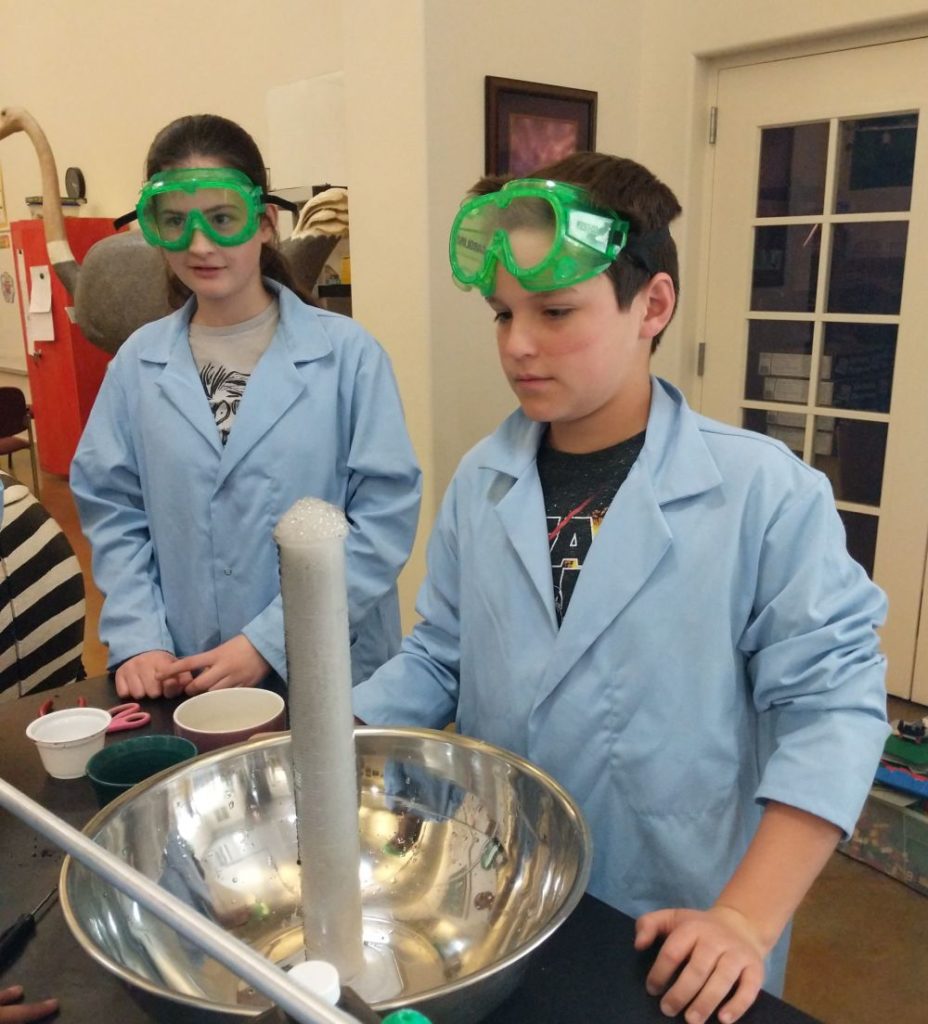MORE PICTURES TO COME
Elephant toothpaste: lotsa foam! Well, I’ve seen many elephants in the wild in Kenya, but I have to admit none was brushing his or her teeth. Still, here’s a dramatic generation of bubbles and foam from simple household items. The explanation leads to additional interesting concepts.
Equipment and supplies: hydrogen peroxide – regular home strength (3%) or super-duty hair-salon strength (20%); packaged yeast or compressed wet yeast (“cake yeast”); dish detergent; a tall cylinder such as a laboratory graduated cylinder, about 30 cm (1’) high and 4 cm wide (around 2”); a wide basin to catch the foam; for the follow-on experiments, a heat source (e.g., a microwave oven) and a cup to hold the yeast mix, an old alkaline cell, C or D size, side-cutters, and a small spoon.
Precautions: This is a pretty safe demo. If you proceed to the experiments with heat and with contents of an old battery (cell, really), take care to avoid getting scalded or cut.
Start with a demo, end with experiments. For the demo, put about 100 ml (around ½ cup, in old English units) of hydrogen peroxide into the cylinder. Add dish detergent and swirl the cylinder to mix it in. In a cup, put about 30 ml (2 Tbsp.) of warm – not hot – water, then add the yeast. Mix the yeast around and let it activate for a few minutes. You’ll get a thick-ish suspension of the yeast. Add it quickly to the peroxide/detergent! A rapid fountain of bubbles shoots up and over the top of the cylinder. Be sure to catch the overflow in a basin.
 VIDEO TO COME
VIDEO TO COME
What happened? Yeast cells, as almost all living cells, have the extremely active enzyme, catalase, to protect them from oxygen in some of its dangerous forms. Start with the idea of a catalyst: it’s an item – a solid, a protein in solution, whatever – that increases the rate of a chemical reaction while ending up unchanged in the end. It participates in the “middle” of a chemical reaction but leaves it after speeding up the reaction. The cells in your body have several thousand different kinds of enzymes that catalyze almost every last chemical reaction that keeps you going. They not only speed the biochemical reactions but also control their rates, precisely. Catalysts occur all over the place. Gasoline is made from oil with the help of catalysts, precious metals on supporting structures. Ammonia as an agricultural fertilizer is made in quantities of more than 180 million tonnes (metric tons, 1000 kilograms each) every year, again using catalyst.
OK, why catalase, specifically? What’s the danger of oxygen? Many living cells such as our own use oxygen as the oxidizer to combine with fuels (sugars, fats, etc.) to release energy in controlled fashion. The process has a number of steps. At several steps, it’s possible to generate forms of oxygen that are potentially damaging to the other contents of the cell. One of these is peroxide, such as the hydrogen peroxide we added externally in this demo. A single molecule of catalase can break down almost 3 million molecules of hydrogen peroxide per second to water and normal gaseous oxygen. The reaction is written as
Variation: a second demo, or an experiment: Is catalase “alive”? OK, no chemical by itself is alive, only the whole set of chemicals in an intact cell or organism. However, what if the yeast cells are dead? Is catalase still active?
* You can experiment with ways to kill the yeast cells before adding them to the peroxide+detergent mix, or
* You can follow the instructions here as just a demonstration, though you will learn some more principles of science
As the demo: Let’s kill the yeast cells. They have no feeling, and you kill them in baking a yeast-raised bread or pastry, while the species lives on. One way to kill the cells is to heat them. After you make the yeast and water slurry, put the cup with them into the microwave and briefly boil them. Be careful not to have the slurry boil over. Let the slurry cool down so that the temperature is about the same as the first demo, to show that any changes in performance are not from temperature differences (learn to change one experimental variable at a time, if it’s possible). Add the slurry to a new peroxide+detergent mix. Does it foam really well? OK, if I don’t tell you what happens, it’s partly an experiment, beyond just a demo.
Variation: a third demo, or an experiment: Are there other things that can act as a catalyst to break down hydrogen peroxide quickly?
* You can experiment with them, trying them out, adding them to the peroxide+detergent mix.
* You can follow the instructions here as just a demonstration, though you will learn some more principles of science
As the demo: Let’s use manganese dioxide from an old alkaline cell (commonly called a battery, which is not really correct; batteries are made up of two or more cells). Cut into the cell with care not to cut yourself. I find it practical to use side-cutters (PICTURE), first, end-on to puncture the zinc wall, then in chewing motions to really open up the interior. The black sludge is manganese dioxide or some product of its reaction to make electricity. Scoop some out and mix it in water to make a slurry, as you did with yeast. Add the slurry to a new peroxide+detergent mix. Does it foam really well? Well, it foams, but far, far more slowly than with yeast. Nothing beats catalase as a catalyst for decomposing peroxide.
